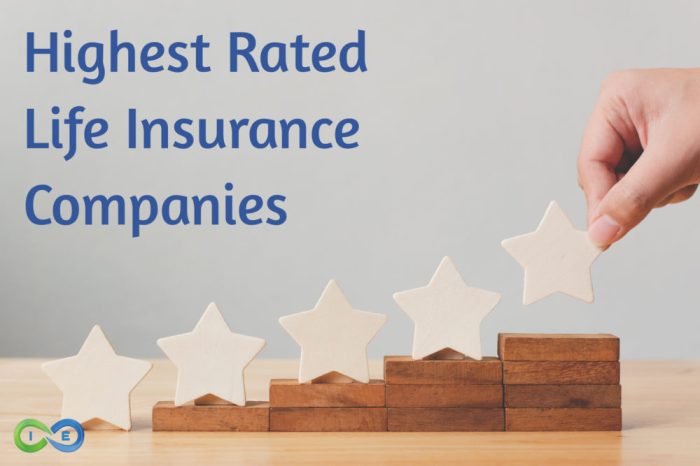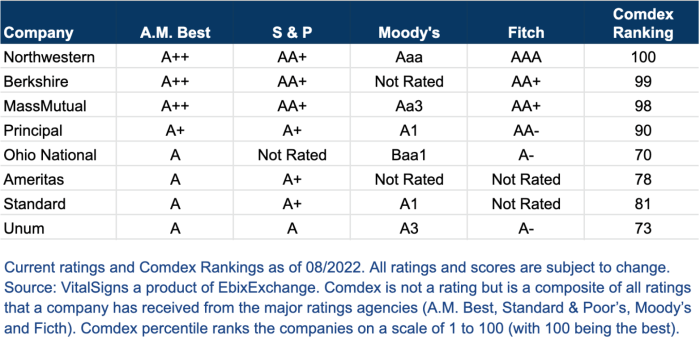Choosing the right insurance provider is a crucial decision, impacting financial security and peace of mind. Navigating the complex world of insurance ratings can feel overwhelming, with numerous companies and varying methodologies. This guide aims to demystify the process, providing a clear understanding of how insurance companies are rated and helping you identify the best-rated options for your specific needs.
We’ll explore different rating agencies, their criteria, and the key factors that contribute to a high rating, including financial stability, customer satisfaction, and claims handling efficiency. By examining these elements, you can make an informed decision and select an insurance company that aligns with your priorities and expectations.
Defining “Best Rated”
Determining the “best rated” insurance company requires a nuanced understanding of the various rating methodologies employed by independent agencies. These agencies assess insurers based on a range of financial strength, claims-paying ability, and operational efficiency. Understanding these methodologies is crucial for consumers seeking reliable and financially stable insurance providers.
Rating Methodologies and Agencies
Several reputable rating agencies utilize different criteria to evaluate insurance companies. These criteria often include financial stability, claims-paying ability, management quality, and the overall strength of the insurer’s business model. The ratings themselves typically range from excellent to poor, offering consumers a relative comparison of different insurers within a specific market segment. Examples of prominent rating agencies include AM Best, Moody’s, Standard & Poor’s (S&P), and Fitch Ratings.
Comparison of Rating Systems
While all four major rating agencies aim to assess the financial strength and creditworthiness of insurance companies, their methodologies and weighting of different factors can vary. This leads to potential discrepancies in the final ratings assigned to a particular insurer. For example, one agency might place greater emphasis on an insurer’s reserve levels, while another might focus more heavily on its underwriting performance. Understanding these nuances is vital for consumers to interpret ratings effectively. A higher rating from one agency doesn’t automatically translate to a similar rating from another.
Rating Agency Comparison Table
| Rating Agency | Methodology | Data Sources | Strengths |
|---|---|---|---|
| AM Best | Focuses on the insurer’s balance sheet strength, operating performance, and business profile. Emphasizes the ability to pay claims. | Financial statements, regulatory filings, market data, and on-site examinations. | Long history in the insurance industry, detailed analysis, and a focus on claims-paying ability. |
| Moody’s | Uses a quantitative and qualitative assessment, considering financial strength, operational efficiency, and management quality. | Financial statements, regulatory filings, industry reports, and management interviews. | Globally recognized, strong analytical capabilities, and a broad perspective on the financial markets. |
| Standard & Poor’s (S&P) | Similar to Moody’s, employing a combination of quantitative and qualitative analysis, with a focus on financial risk and creditworthiness. | Financial statements, regulatory filings, market data, and industry analysis. | Widely recognized and respected for its credit ratings across various sectors, including insurance. |
| Fitch Ratings | Utilizes a comprehensive evaluation framework, incorporating financial analysis, operational review, and assessment of management and governance. | Financial statements, regulatory filings, industry data, and direct interaction with insurers. | Global reach, strong analytical expertise, and a focus on transparency and objectivity. |
Key Factors Influencing Ratings

Insurance company ratings reflect a complex interplay of various factors, ultimately aiming to assess the insurer’s ability to meet its financial obligations to policyholders. These ratings are crucial for consumers seeking reliable coverage and for investors evaluating the stability of insurance companies. Understanding the key factors influencing these ratings provides valuable insight into the overall health and trustworthiness of an insurer.
Several key aspects contribute to an insurance company’s overall rating. These factors are carefully weighed and analyzed by rating agencies to provide a comprehensive assessment of the company’s financial strength and operational efficiency.
Financial Stability
Financial stability is paramount in determining an insurance company’s rating. It encompasses several aspects, including the company’s capital adequacy, investment portfolio performance, and overall profitability. A strong balance sheet, characterized by sufficient reserves to cover potential claims and withstand economic downturns, is a crucial indicator of financial stability. Rating agencies meticulously examine an insurer’s financial statements, scrutinizing metrics like the ratio of reserves to liabilities and the level of surplus capital. For example, a company with a high surplus capital to liabilities ratio demonstrates a greater capacity to absorb unexpected losses, positively impacting its rating. Conversely, a company struggling with profitability and insufficient reserves would likely receive a lower rating, signaling potential financial instability.
Customer Satisfaction
Customer satisfaction significantly influences an insurance company’s rating. High customer satisfaction indicates a positive experience with the company’s products and services, encompassing areas such as ease of policy purchase, clarity of policy terms, responsiveness of customer service, and efficiency of claims processing. Rating agencies often incorporate customer satisfaction surveys and reviews into their assessment. A company known for its excellent customer service, prompt claims handling, and transparent communication generally receives a better rating than one with a history of poor customer service and lengthy claim settlement times. For instance, a company consistently receiving high marks in customer satisfaction surveys might be seen as more reliable and trustworthy.
Claims Handling Processes
The efficiency and fairness of claims handling processes are critical components of an insurance company’s rating. Rating agencies assess how quickly and effectively claims are processed, the level of transparency throughout the process, and the fairness of claim settlements. Companies with streamlined claims processes, clear communication, and a reputation for resolving claims fairly tend to receive higher ratings. Conversely, insurers known for delaying claims, engaging in protracted disputes, or consistently underpaying claims receive lower ratings. For example, a company with a high percentage of claims settled within a reasonable timeframe and with minimal customer complaints will likely receive a better rating than a company with a history of slow and contentious claim settlements.
Underwriting Practices
Effective underwriting practices play a crucial role in an insurance company’s financial stability and overall rating. This involves carefully assessing risk and setting appropriate premiums to ensure the company can meet its obligations. Rating agencies examine an insurer’s underwriting guidelines, loss ratios, and risk management strategies. Companies with strong underwriting practices, leading to lower loss ratios and consistent profitability, typically receive higher ratings. Conversely, poor underwriting practices, such as accepting high-risk policies at inadequate premiums, can lead to increased losses and negatively impact the company’s rating.
Management Quality and Corporate Governance
The quality of management and corporate governance practices are essential elements influencing an insurance company’s rating. This includes the experience and expertise of the management team, the effectiveness of internal controls, and the transparency of corporate governance structures. Rating agencies evaluate the company’s strategic planning, risk management framework, and overall operational efficiency. Companies with strong management teams, robust internal controls, and transparent governance structures are generally perceived as more stable and reliable, resulting in higher ratings. Conversely, weak management, inadequate risk management, and a lack of transparency can lead to lower ratings.
Relative Importance of Key Factors
While all these factors are important, their relative weight in determining an overall rating can vary depending on the specific rating agency and the type of insurance being offered. However, a general ranking based on their broad influence might look like this:
- Financial Stability: This is usually the most significant factor, reflecting the company’s ability to meet its obligations.
- Underwriting Practices: Effective risk assessment and premium setting directly impact financial stability.
- Claims Handling Processes: Efficient and fair claims handling builds trust and reduces potential liabilities.
- Customer Satisfaction: High customer satisfaction reflects positive operational efficiency and builds a strong reputation.
- Management Quality and Corporate Governance: Strong leadership and transparent governance contribute to overall stability and long-term success.
Analyzing Customer Reviews and Complaints

Understanding customer sentiment is crucial for assessing an insurance company’s true performance. While ratings agencies provide valuable insights, a comprehensive evaluation necessitates a deep dive into customer feedback, both positive and negative. Analyzing reviews and complaints reveals areas of strength and weakness, offering a more nuanced perspective than numerical ratings alone.
Analyzing customer reviews allows for the identification of recurring themes and patterns in customer satisfaction. By systematically examining feedback, insurance companies can pinpoint specific aspects of their services that are consistently praised or criticized. This data-driven approach allows for targeted improvements, ultimately enhancing customer loyalty and the overall reputation of the company.
Identifying Trends in Customer Satisfaction
A systematic approach to analyzing customer reviews involves employing sentiment analysis tools and manually reviewing a representative sample of feedback. This dual approach allows for a balanced perspective, combining automated analysis with the nuanced understanding provided by human interpretation. For example, analyzing reviews mentioning specific claims processes, such as the speed of claim settlements or the clarity of communication, can reveal areas needing improvement. Similarly, identifying positive feedback related to customer service representatives or the ease of online policy management can highlight successful aspects of the business model. By categorizing reviews into themes (e.g., claims handling, customer service, policy clarity), a clear picture of customer satisfaction emerges. A visual representation, such as a bar chart showing the frequency of each theme, can effectively communicate these findings.
The Significance of Complaint Ratios
The ratio of complaints received relative to the number of policies held is a key indicator of an insurance company’s performance. A high complaint ratio, even with high overall satisfaction scores, may signal underlying issues. For instance, a company with a high complaint ratio related to claim denials might indicate overly strict claim assessment processes. Conversely, a low complaint ratio, coupled with high customer satisfaction scores, strongly suggests effective service delivery and customer-centric practices. Regulatory bodies often monitor complaint ratios as a measure of consumer protection, and high ratios can lead to increased scrutiny and potential penalties. Therefore, maintaining a low and manageable complaint ratio is essential for maintaining a strong reputation and favorable ratings.
Interpreting Customer Feedback for Service Improvements
Customer feedback provides valuable insights into areas needing improvement. For example, frequently recurring complaints about long wait times for customer service calls suggest the need for additional staffing or improved call routing systems. Negative comments about unclear policy language might indicate a need for policy revisions or more accessible explanations. Positive feedback, on the other hand, should be analyzed to identify best practices and successful strategies that can be replicated across the company. By systematically categorizing and analyzing feedback, insurance companies can prioritize improvements based on the frequency and severity of complaints, ensuring resources are allocated effectively.
Organizing Key Themes and Issues from Customer Reviews
To effectively manage and analyze customer feedback, a structured approach is vital. One effective method is to create a thematic matrix. This involves categorizing all feedback into pre-defined themes (e.g., claims process, customer service, policy clarity, billing). Within each theme, sub-categories can be created to further refine the analysis. For example, under the “claims process” theme, sub-categories could include “speed of settlement,” “communication clarity,” and “fairness of assessment.” This structured approach facilitates the identification of recurring issues and trends within each theme, allowing for a focused and targeted response. The resulting data can be used to inform strategic decisions, such as improving processes, enhancing training programs, or modifying policies to better meet customer needs.
Final Thoughts

Ultimately, selecting a “best-rated” insurance company requires careful consideration of your individual circumstances and priorities. While ratings provide valuable insights into a company’s performance and financial stability, it’s crucial to compare quotes, review customer feedback, and consider the specific coverage options offered. By using this guide as a framework, you can confidently navigate the insurance landscape and choose a provider that offers both excellent service and the protection you need.
Common Queries
What does a high insurance rating actually mean?
A high rating generally indicates a company’s strong financial stability, efficient claims processing, and high customer satisfaction. It suggests a lower likelihood of insolvency and a greater capacity to meet its obligations.
How often are insurance company ratings updated?
Rating agencies update their assessments periodically, often annually or more frequently if significant changes occur within a company.
Do all rating agencies use the same criteria?
No, each agency employs its own methodology and weighting of factors, leading to potential variations in ratings for the same company.
Can I rely solely on ratings when choosing an insurer?
No, ratings are a valuable tool but shouldn’t be the sole determinant. Consider your individual needs, compare quotes, and read customer reviews for a holistic assessment.